Chemical, Antioxidant and Biological Studies of Brassica incana subsp. raimondoi (Brassicaceae) Leaf Extract
Abstract
:1. Introduction
2. Results
2.1. Phytochemical Analysis
2.1.1. Determination of Total Polyphenols, Flavonoids, and Condensed Tannins
2.1.2. Ultra-Performance Liquid Chromatography-Mass Spectrometry Analysis
2.1.3. Polyphenolic Profile Characterization by HPLC/DAD Analysis
2.2. In Vitro Cell-Free Antioxidant Properties
DPPH (2,2-diphenyl-1-picrylhydrazyl), Sod-like Activity, β-Carotene Bleaching, Reducing Power and Chelating Activity Assays
2.3. Toxicity
2.3.1. Cytotoxicity on Normal and Cancer Cells by MTT Assay
2.3.2. LDH Release
2.3.3. Toxicity Assessment by Artemia salina Leach Lethality Bioassay
2.4. Determination of Reactive Oxygen Species (ROS) and Non-Protein Thiol groups (RSH) in Oxidative Stress H2O2-Induced HepG2 Cells
3. Discussion
4. Materials and Methods
4.1. Chemicals
4.2. Plant Collection and Extraction Procedure
4.3. Phytochemical Analysis
4.3.1. Spectrophotometric Determination of Total Polyphenols
4.3.2. Spectrophotometric Determination of Total Flavonoids
4.3.3. Spectrophotometric Determination of Condensed Tannins
4.3.4. Ultra-Performance Liquid Chromatography-Mass Spectrometry (UPLC-MS/MS)
4.3.5. High-Pressure Liquid Chromatography Diode-Array Detection (HPLC-DAD)
4.4. In Vitro Antioxidant and Free Radical Scavenging Activity
4.4.1. 2,2-diphenyl-2-picrylhydrazyl (DPPH) Assay
4.4.2. SOD-Superoxide Dismutase like Activity
4.4.3. β-Carotene Bleaching Test
4.4.4. Reducing Power Assay
4.4.5. Ferrous Ion (Fe2+) Chelating Activity
4.5. Cell Culture
4.6. Cytotoxicity Assays
4.6.1. MTT Assay
4.6.2. Lactate Dehydrogenase Release
4.6.3. Artemia salina Leach Lethality Bioassay
4.7. Antioxidant Activities in Cell
4.7.1. Reactive Oxigen Species Determination
4.7.2. Non-Protein Thiol Groups Determination
4.8. Statistical Analysis
5. Conclusions
Author Contributions
Funding
Institutional Review Board Statement
Informed Consent Statement
Data Availability Statement
Acknowledgments
Conflicts of Interest
Sample Availability
References
- Maggioni, L.; Bothmer, R.; von Poulsen, G.; Branca, F. Originband domestication of cole crops (Brassica oleracea L.): Linguistic and literary considerations. Econ. Bot. 2010, 64, 109–123. [Google Scholar] [CrossRef]
- Branca, F.; Chiarenza, G.L.; Cavallaro, C.; Gu, H.; Zhao, Z.; Tribulato, A. Diversity of Sicilian broccoli (Brassica oleracea var. italica) and cauliflower (Brassica oleracea var. botrytis) landraces and their distinctive bio-morphological, antioxidant, and genetic traits. Genet. Resour. Crop Evol. 2018, 65, 485–502. [Google Scholar] [CrossRef]
- Ruggles Gates, R. Wild cabbages and the effects of cultivation. J. Genet. 1953, 51, 363–372. [Google Scholar] [CrossRef]
- Malfa, G.A.; Acquaviva, R.; Bucchini, A.A.E.; Ragusa, S.; Raimondo, F.M.; Spadaro, V. The Sicilian wild cabbages as biological resources: Taxonomic update and a review on chemical constituents and biological activities. Flora Mediterr. 2020, 30, 245–260. [Google Scholar]
- Faulkner, K.; Mithen, R.; Williamson, G. Selective increase of the potential anticarcinogen 4-methylsulphinylbutyl glucosinolate in broccoli. Carcinogenesis 1998, 19, 605–609. [Google Scholar] [CrossRef] [PubMed] [Green Version]
- Quezada-Martinez, D.; Addo Nyarko, C.P.; Schiessl, S.V.; Mason, A.S. Using wild relatives and related species to build climate resilience in Brassica crops. Theor. Appl. Genet. 2021, 134, 1711–1728. [Google Scholar] [CrossRef] [PubMed]
- Gupta, E.; Mishra, P. Functional Food with Some Health Benefits, So Called Superfood: A Review. Curr. Nutr. Food Sci. 2021, 17, 144–166. [Google Scholar] [CrossRef]
- Jahangir, M.; Kim, H.K.; Choi, Y.; Verpoorte, R. Health-Affecting Compounds in Brassicaceae. Compr. Rev. Food Sci. Food Saf. 2009, 8, 31–43. [Google Scholar] [CrossRef]
- Malfa, G.A.; De Leo, M.; Tundis, R.; Braca, A.; Loizzo, M.R.; Di Giacomo, C.; Raimondo, F.M.; Bucchini, A.E.A.; Acquaviva, R. Biological Investigation and Chemical Study of Brassica villosa subsp. drepanensis (Brassicaeae) Leaves. Molecules 2022, 27, 8447. [Google Scholar] [CrossRef]
- Mattosinhos, P.D.S.; Sarandy, M.M.; Novaes, R.D.; Esposito, D.; Gonçalves, R.V. Anti-Inflammatory, Antioxidant, and Skin Regenerative Potential of Secondary Metabolites from Plants of the Brassicaceae Family: A Systematic Review of in vitro and in vivo preclinical evidence (Biological Activities Brassicaceae Skin Diseases). Antioxidants 2022, 11, 1346. [Google Scholar] [CrossRef]
- Owis, A.I. Broccoli; the green beauty: A review. J. Pharm. Sci. Res. 2015, 7, 696–703. [Google Scholar]
- Ramirez, D.; Abellán-Victorio, A.; Beretta, V.; Camargo, A.; Moreno, D.A. functional ingredients from Brassicaceae species: Overview and Perspectives. Int. J. Mol. Sci. 2020, 21, 1998. [Google Scholar] [CrossRef] [Green Version]
- Palak, S.K.; Thakur, A.; Kohli, K. Broccoli: An Insight into Formulation and Patentability Aspects. Drug Des. 2016, 5, 139. [Google Scholar]
- Sciandrello, S.; Brullo, C.; Brullo, S.; Giusso Del Galdo, G.; Minissale, P.; Salmeri, C. A new species of Brassica sect. Brassica (Brassicaceae) from Sicily. Plant Biosyst. 2013, 147, 812–820. [Google Scholar] [CrossRef]
- Hamidi, M.R.; Jovanova, B.; Panovska, T.K. Toxicological evaluation of the plant products using brine shrimp (Artemia salina L.) model. Maced. Pharm. Bull. 2014, 60, 9–18. [Google Scholar] [CrossRef]
- Raimondo, F.M.; Domina, G.; Spadaro, V. Checklist of the vascular flora of Sicily. Quad. Di Bot. Ambient. E Appl. 2010, 21, 189–252. [Google Scholar]
- Sciandrello, S.; Guarino, R.; Minissale, P.; Spampinato, G. The endemic vascular flora of Peloritani Mountains (NE Sicily): Plant functional traits and phytogeographical relationships in the most isolated and fragmentary micro-plate of the Alpine orogeny. Plant Biosyst. 2015, 149, 838–854. [Google Scholar] [CrossRef] [Green Version]
- Farag, M.A.; Porzel, A.; Wessjohann, L.A. Comparative metabolite profiling and fingerprinting of medicinal licorice roots using a multiplex approach of GC-MS, LC-MS and 1D NMR techniques. Phytochemistry 2012, 76, 60–72. [Google Scholar] [CrossRef]
- Miceli, N.; Cavò, E.; Ragusa, M.; Cacciola, F.; Mondello, L.; Dugo, L.; Acquaviva, R.; Malfa, G.A.; Marino, A.; D’Arrigo, M.; et al. Brassica incana Ten. (Brassicaceae): Phenolic constituents, antioxidant and cytotoxic properties of the leaf and flowering top extracts. Molecules 2020, 25, 1461. [Google Scholar] [CrossRef] [Green Version]
- Picchi, V.; Lo Scalzo, R.; Tava, A.; Doria, F.; Argento, S.; Toscano, S.; Treccarichi, S.; Branca, F. Phytochemical Characterization and In Vitro Antioxidant Properties of Four Brassica Wild Species from Italy. Molecules 2020, 25, 3495. [Google Scholar] [CrossRef]
- Mageney, V.; Neugart, S.; Albach, D.C. A Guide to the Variability of Flavonoids in Brassica oleracea. Molecules 2017, 22, 252. [Google Scholar] [CrossRef] [Green Version]
- Yao, L.H.; Jiang, Y.M.; Shi, J.; Tomás-Barberán, F.A.; Datta, N.; Singanusong, R.; Chen, S.S. Flavonoids in food and their health benefits. Plant Foods Hum. Nutr. 2004, 59, 113–122. [Google Scholar] [CrossRef] [PubMed]
- Xiao, Z.P.; Peng, Z.Y.; Peng, M.J.; Yan, W.B.; Ouyang, Y.Z.; Zhu, H.L. Flavonoids health benefits and their molecular mechanism. Mini Rev. Med. Chem. 2011, 11, 169–177. [Google Scholar] [CrossRef] [PubMed]
- Kumar, S.; Pandey, A.K. Chemistry and biological activities of flavonoids: An overview. Sci. World J. 2013, 2013, 162750. [Google Scholar] [CrossRef] [PubMed] [Green Version]
- Kopsell, D.A.; McElroy, J.S.; Sams, C.E.; Kopsell, D.E. Genetic Variation in Carotenoid Concentrations among Diploid and Amphidiploid Rapid-cycling Brassica Species. HortScience 2007, 42, 461–465. [Google Scholar] [CrossRef] [Green Version]
- Kasote, D.M.; Katyare, S.S.; Hegde, M.V.; Bae, H. Significance of antioxidant potential of plants and its relevance to therapeutic applications. Int. J. Biol. Sci. 2015, 11, 982–991. [Google Scholar] [CrossRef] [Green Version]
- Yang, J.; Chen, J.; Hao, Y.; Liu, Y. Identification of the DPPH radical scavenging reaction adducts of ferulic acid and sinapic acid and their structure-antioxidant activity relationship. LWT 2021, 146, 111411. [Google Scholar] [CrossRef]
- Liu, P.F.; Deng, T.S.; Hou, X.L.; Wang, J.G. Antioxidant properties of isolated isorhamnetin from the sea buckthorn marc. Plant Foods Hum. Nutr. 2009, 64, 141–145. [Google Scholar]
- Cai, Y.-Z.; Sun, M.; Xing, J.; Luo, Q.; Corke, H. Structure-radical scavenging activity relationships of phenolic compounds from traditional Chinese medicinal plants. Life Sci. 2006, 78, 2872–2888. [Google Scholar] [CrossRef]
- Fu, H.; Xie, B.; Ma, S.; Zhu, X.; Fan, G.; Pan, S. Evaluation of antioxidant activities of principal carotenoids available in water spinach (Ipomoea aquatica). J. Food Comp. Anal. 2011, 24, 288–297. [Google Scholar] [CrossRef]
- Wang, C.C.; Chang, S.C.; Inbaraj, B.S.; Chen, B.H. Isolation of carotenoids, flavonoids and polysaccharides from Lycium barbarum L. and evaluation of antioxidant activity. Food Chem. 2010, 120, 184–192. [Google Scholar] [CrossRef]
- Jiménez Escrig, A.; Jiménez-Jiménez, I.; Sánchez-Moreno, C.; Saura, C.; Fulgencio, D. Evaluation of free radical scavenging of dietary carotenoids by the stable radical 2,2-diphenyl-1-picrylhydrazyl. J. Sci. Food Agric. 2000, 80, 1686–1690. [Google Scholar] [CrossRef]
- Ntungwe, N.E.; Domínguez-Martín, E.M.; Roberto, A.; Tavares, J.; Isca, V.M.S.; Pereira, P.; Cebola, M.J.; Rijo, P. Artemia species: An important tool to screen general toxicity samples. Curr. Pharm. Des. 2020, 26, 2892–2908. [Google Scholar] [CrossRef]
- Kopustinskiene, D.M.; Jakstas, V.; Savickas, A.; Bernatoniene, J. Flavonoids as Anticancer Agents. Nutrients 2020, 12, 457. [Google Scholar] [CrossRef] [PubMed] [Green Version]
- Milani, A.; Basirnejad, M.; Shahbazi, S.; Bolhassani, A. Carotenoids: Biochemistry, pharmacology and treatment. Br. J. Pharmacol. 2017, 174, 1290–1324. [Google Scholar] [CrossRef] [Green Version]
- Moran, N.E.; Mohn, E.S.; Hason, N.; Erdman, J.W., Jr.; Johnson, E.J. Intrinsic and Extrinsic Factors Impacting Absorption, Metabolism, and Health Effects of Dietary Carotenoids. Adv. Nutr. 2018, 9, 465–492. [Google Scholar] [CrossRef] [Green Version]
- Muangnoi, C.; Phumsuay, R.; Jongjitphisut, N.; Waikasikorn, P.; Sangsawat, M.; Rashatasakhon, P.; Paraoan, L.; Rojsitthisak, P. Protective Effects of a Lutein Ester Prodrug, Lutein Diglutaric Acid, against H2O2-Induced Oxidative Stress in Human Retinal Pigment Epithelial Cells. Int. J. Mol. Sci. 2021, 22, 4722. [Google Scholar] [CrossRef]
- Donato, M.T.; Tolosa, L.; Gómez-Lechón, M.J. Culture and Functional Characterization of Human Hepatoma HepG2 Cells. Methods Mol. Biol. 2015, 1250, 77–93. [Google Scholar] [CrossRef]
- Wu, G.; Fang, Y.Z.; Yang, S.; Lupton, J.R.; Turner, N.D. Glutathione metabolism and its implications for health. J. Nutr. 2004, 134, 489–492. [Google Scholar] [CrossRef] [Green Version]
- Ballatori, N.; Krance, S.M.; Notenboom, S.; Shi, S.; Tieu, K.; Hammond, C.L. Glutathione dysregulation and the etiology and progression of human diseases. Biol. Chem. 2009, 390, 191–214. [Google Scholar] [CrossRef] [Green Version]
- Gao, X.; Ohlander, M.; Jeppsson, N.; Bjork, L.; Trajkovski, V. Changes in antioxidant effects and their relationship to phytonutrients in fruits of sea buckthorn (Hippophae rhamnoides L.) during maturation. J. Agric. Food. Chem. 2000, 48, 1485–1490. [Google Scholar] [CrossRef] [PubMed]
- Chang, C.C.; Yang, M.H.; Wen, H.M.; Chern, J.C. Estimation of total flavonoid content in propolis by two complementary colorimetric methods. J. Food Drug Anal. 2002, 10, 178–182. [Google Scholar]
- Julkunen-Titto, R. Phenolic constituents in the leaves of northern willows: Methods for the analysis of certain phenolics. J. Agric. Food Chem. 1985, 33, 213–217. [Google Scholar] [CrossRef]
- Malfa, G.A.; Tomasello, B.; Acquaviva, R.; La Mantia, A.; Pappalardo, F.; Ragusa, M.; Renis, M.; Di Giacomo, C. The antioxidant activities of Betula etnensis Rafin. ethanolic extract exert protective and anti-diabetic effects on streptozotocin-induced diabetes in rats. Antioxidants 2020, 9, 847. [Google Scholar] [CrossRef]
- Ohnishi, M.; Morishita, H.; Iwahashi, H.; Shitzuo, T.; Yoshiaki, S.; Kimura, M.; Kido, R. Inhibitory effects of chlorogenic acid on linoleic acid peroxidation and haemolysis. Phytochemistry 1994, 36, 579–583. [Google Scholar] [CrossRef]
- Genovese, C.; Acquaviva, R.; Ronsisvalle, S.; Tempera, G.; Malfa, G.A.; D’Angeli, F.; Ragusa, S.; Nicolosi, D. In vitro evaluation of biological activities of Orobanche crenata Forssk. leaves extract. Nat. Prod. Res. 2020, 34, 3234–3238. [Google Scholar] [CrossRef]
- Oyaizu, M. Studies on products of browning reaction: Antioxidative activities of products of browning reaction prepared from glucosamine. Jpn. J. Nutr. Diet. 1986, 44, 307–315. [Google Scholar] [CrossRef] [Green Version]
- Kumar, T.S.; Shanmugam, S.; Palvannan, T.; Kumar, V.M.B. Evaluation of antioxidant properties of Elaeocarpus ganitrus Roxb. leaves. Iran. J. Pharm. Res. 2008, 7, 211–215. [Google Scholar]
- Privitera, G.; Luca, T.; Musso, N.; Vancheri, C.; Crimi, N.; Barresi, V.; Condorelli, D.; Castorina, S. In vitro antiproliferative effect of trastuzumab (Herceptin®) combined with cetuximab (Erbitux®) in a model of human non-small cell lung cancer expressing EGFR and HER2. Clin. Exp. Med. 2016, 16, 161–168. [Google Scholar] [CrossRef]
- Acquaviva, R.; Tomasello, B.; Di Giacomo, C.; Santangelo, R.; La Mantia, A.; Naletova, I.; Sarpietro, M.G.; Castelli, F.; Malfa, G.A. Protocatechuic Acid, a Simple Plant Secondary Metabolite, Induced Apoptosis by Promoting Oxidative Stress through HO-1 Downregulation and p21 Upregulation in Colon Cancer Cells. Biomolecules 2021, 11, 1485. [Google Scholar] [CrossRef]
- Meyer, B.N.; Ferrigni, N.R.; Putnam, J.E.; Jacobson, L.B.; Nichols, D.E.; McLaughlin, J.L. Brine shrimp: A convenient general bioassay for active plant constituents. Planta Med. 1982, 45, 31–34. [Google Scholar] [CrossRef] [PubMed]
- Tomasello, B.; Malfa, G.A.; La Mantia, A.; Miceli, N.; Sferrazzo, G.; Taviano, M.F.; Di Giacomo, C.; Renis, M.; Acquaviva, R. Anti-adipogenic and anti-oxidant effects of a standardised extract of Moro blood oranges (Citrus sinensis (L.) Osbeck) during adipocyte differentiation of 3T3-L1 preadipocytes. Nat. Prod. Res. 2021, 35, 2660–2667. [Google Scholar] [CrossRef] [PubMed]
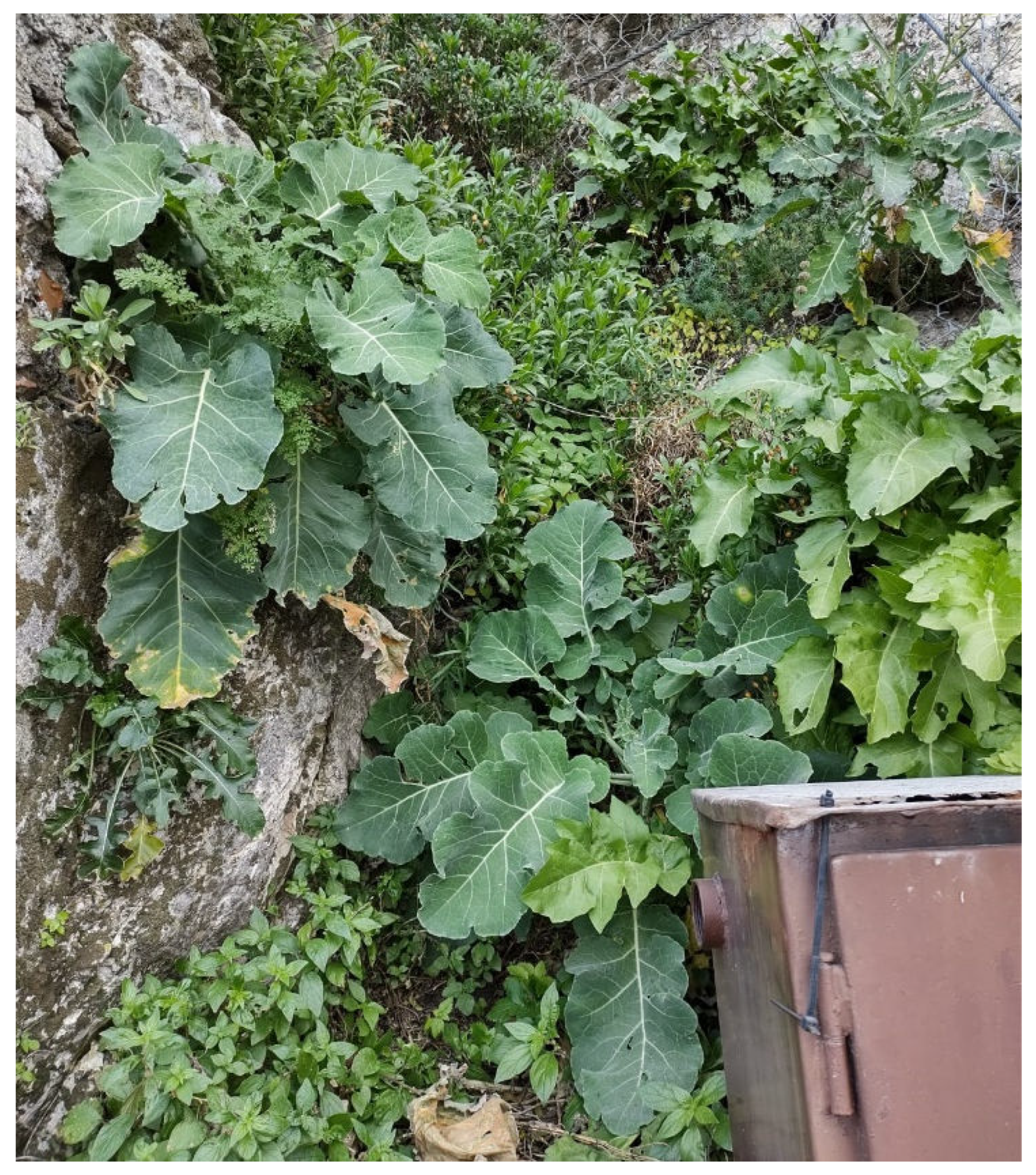
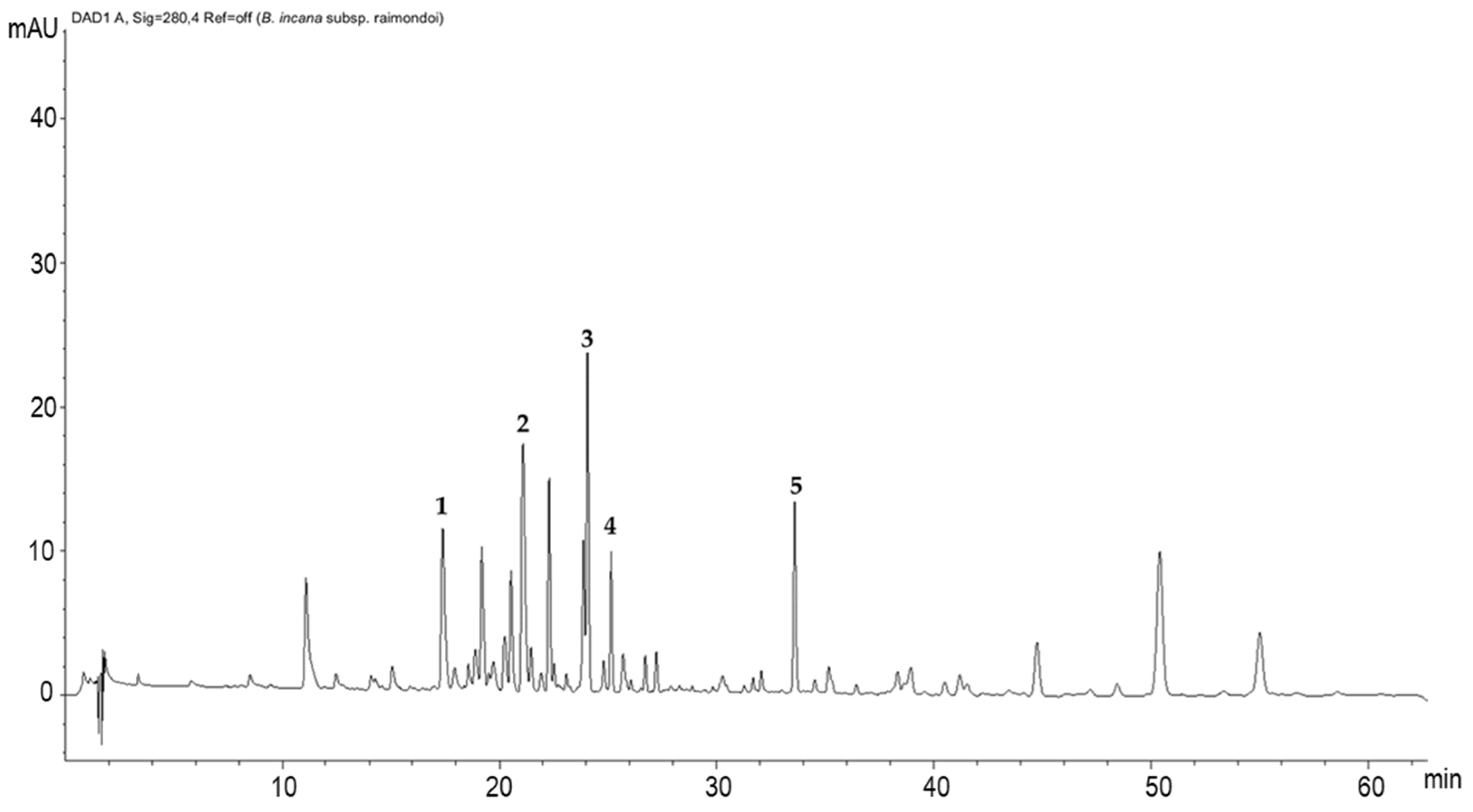
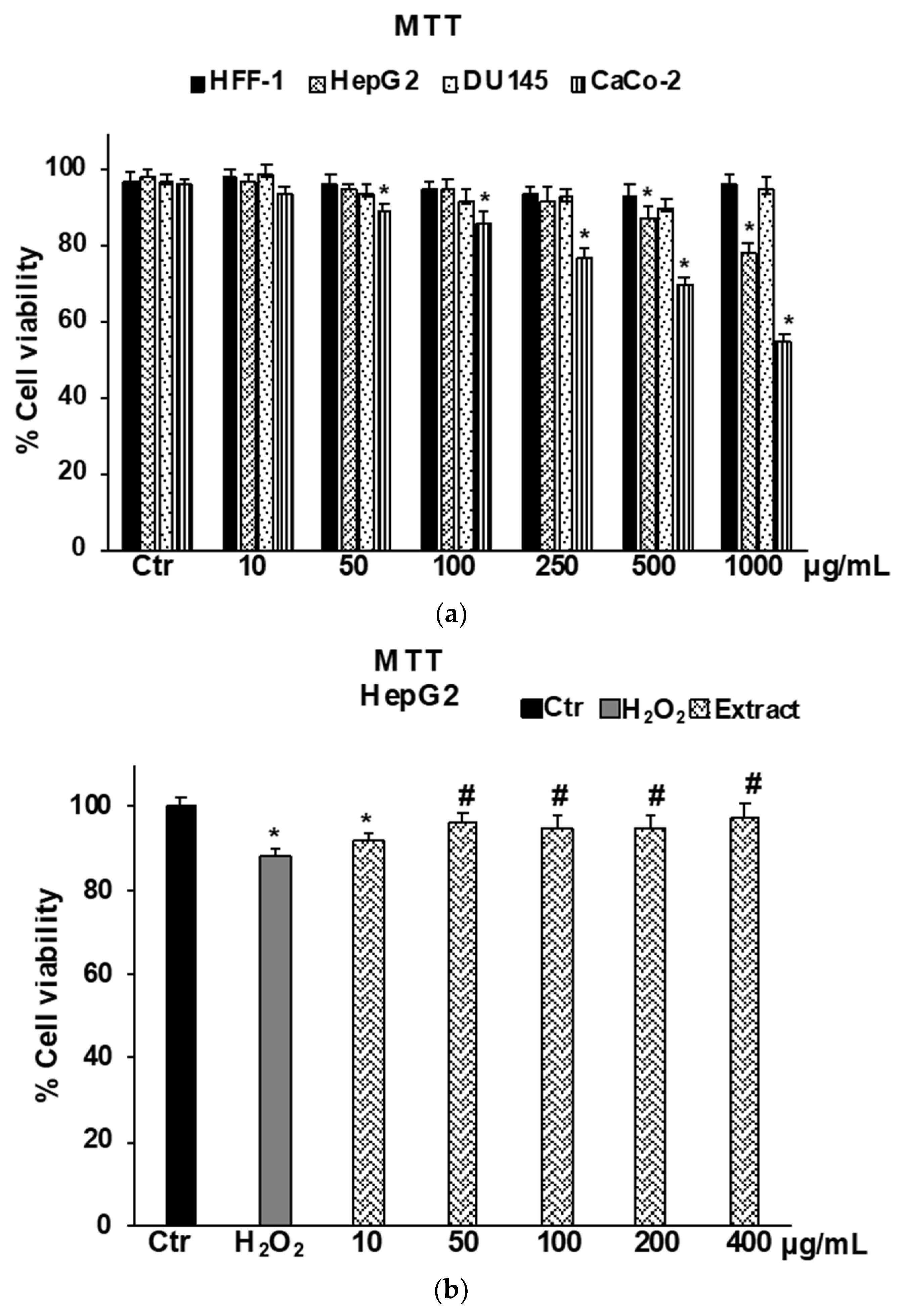
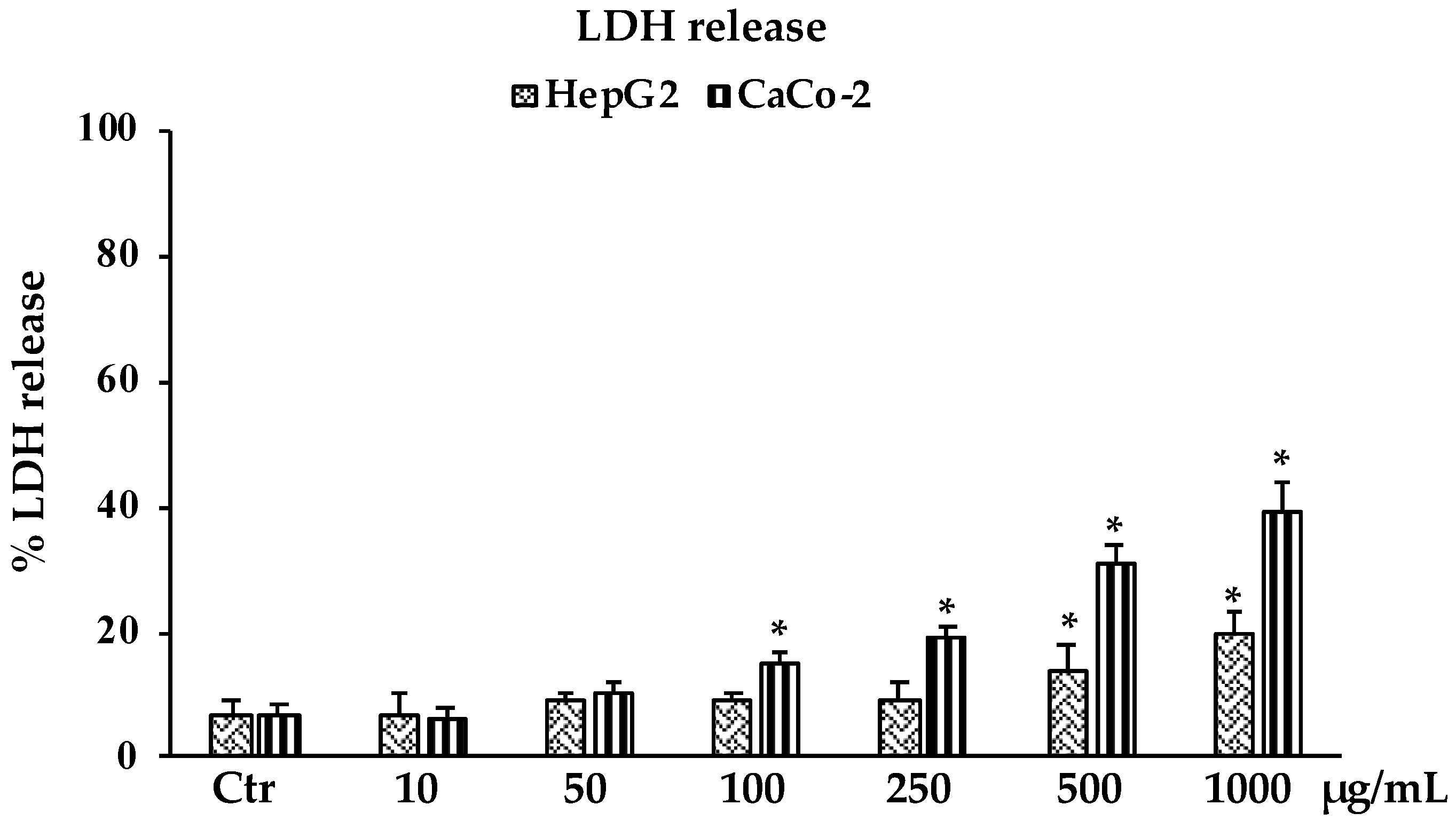
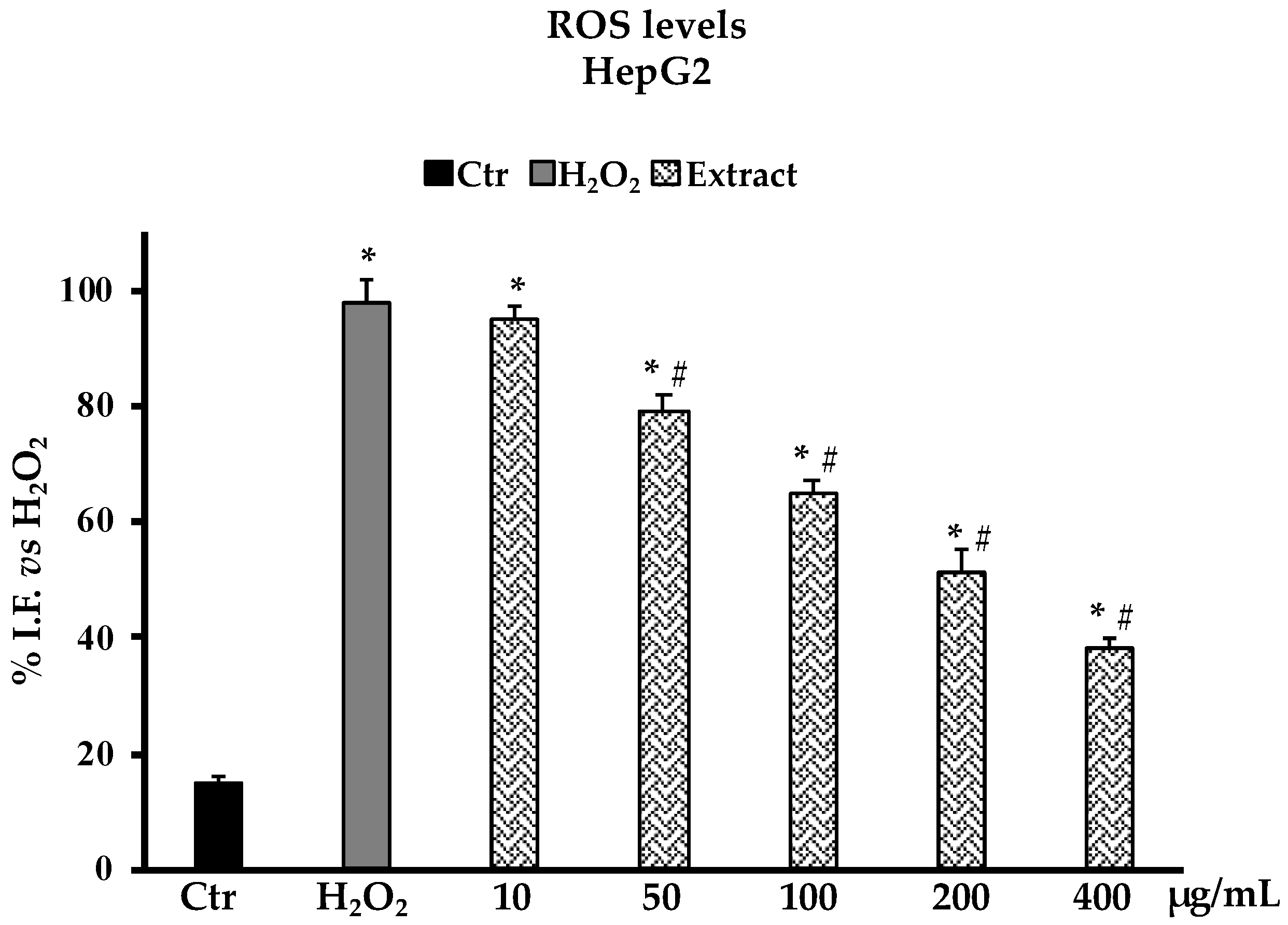
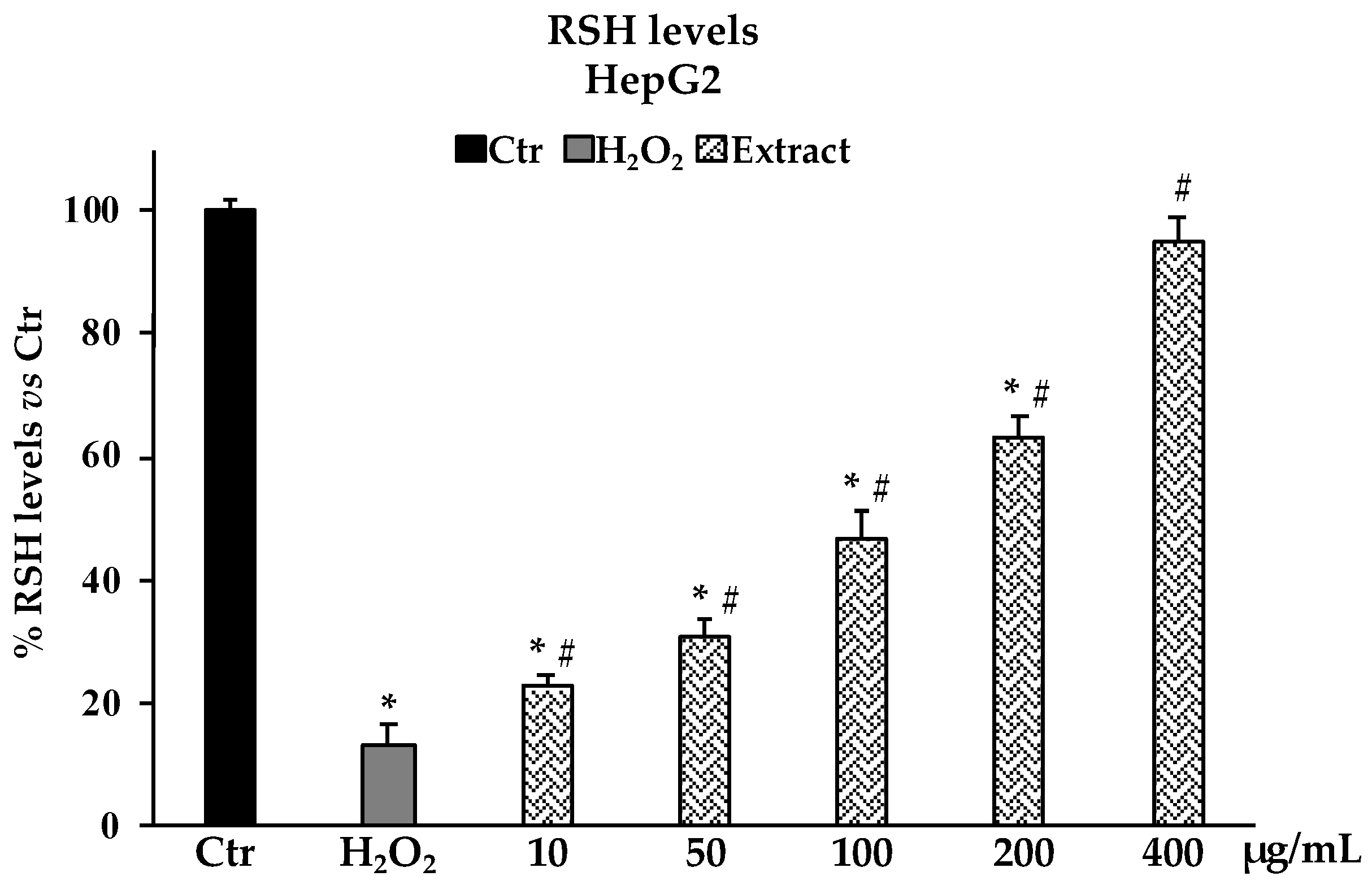
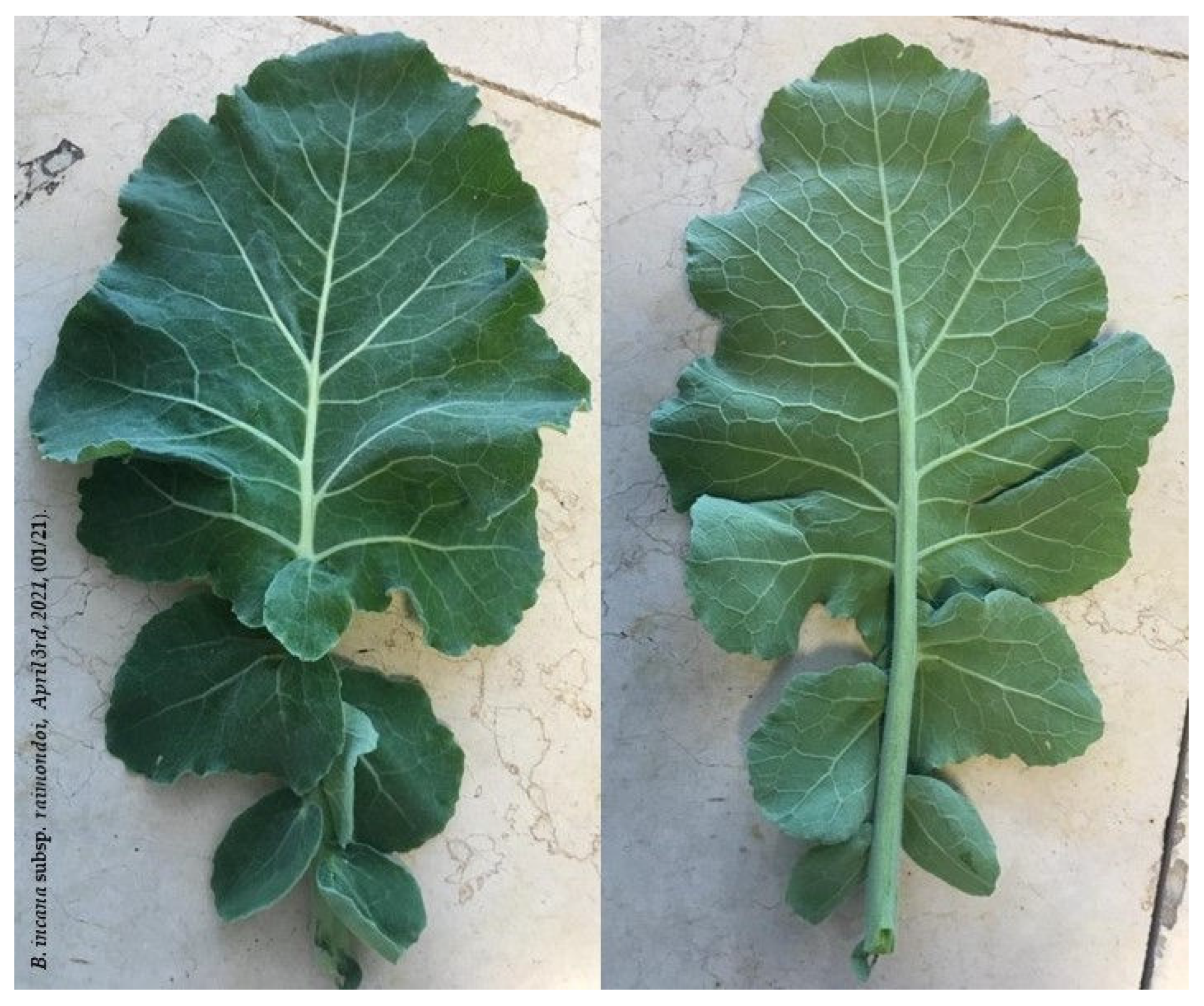
| Total Polyphenols | Total Flavonoids | Condensed Tannins |
|---|---|---|
| 38.12 ± 0.50 | 8.45 ± 0.60 | 4.70 ± 0.07 |
| (mg GAE/g extract) 1 | (mg QE/g extract) 1 | (mg CE/g extract) 1 |
| Compund | Mol. Weight | Polarity | m/z (g/mol) | Intensity (cps) |
|---|---|---|---|---|
| Caffeic Acid | 180.16 | 181.05 (+) 179.04 (−) | 179.04 | 3.5537 × 107 |
| Cryptoxanthin | 552.89 | 553.44 (+) 551.43 (−) | 553.44 | LOQ * |
| Cyanidin | 287.2442 | 288.06 (+) 286.05 (−) | 286.05 | LOQ * |
| Ferulic Acid | 194.184 | 195.07 (+) 193.05 (−) | 193.05 | 9.9457 × 106 |
| Isorhamnetin | 316.2623 | 317.07 (+) 315.07 (−) | 315.07 | 5.1753 × 106 |
| Kaempferol | 286.23 | 287.06 (+) 285.07 (−) | 285.07 | 5.8504 × 106 |
| Luteolin | 286.24 | 287.06 (+) 285.04 (−) | 285.04 | 5.8504 × 106 |
| Neoxanthin | 600.87 | 601.43 (+) 599.41 (−) | 599.41 | LOQ * |
| p-coumaric acid | 164.158 | 165.06 (+) 163.04 (−) | 163.04 | 7.7855 × 106 |
| Quercetin | 302.24 | 303.1 (+) 301.04 (−) | 301.03 | 4.5603 × 106 |
| Sinapic Acid | 224.21 | 225.08 (+) 223.06 (−) | 223.06 | 6.5254 × 106 |
| Violaxanthin | 600.87 | 601.43 (+) 599.41 (−) | 599.41 | LOQ * |
| Zeaxanthin | 568.88 | 569.44 (+) 567.42 (−) | 567.42 | LOQ * |
| α-carotene | 536.87 | 537.45 (+) 535.43 (−) | 535.43 | LOQ * |
| β-carotene | 536.87 | 537.45 (+) 535.43 (−) | 535.43 | LOQ * |
| Peak | Compound | Wavelength (nm) | Ret Time * (min.) |
|---|---|---|---|
| 1 | kaempferol-3-O-diglucoside-7-O-glucoside | 330 | 17.4 |
| 2 | kaempferol-3-hdroxyferuloylsophoroside-7-glucoside | 330 | 21.08 |
| 3 | quercetin-3-feruloyl-diglucoside-7-glucoside | 330 | 24.06 |
| 4 | isorhamnetin-3-glucoside-7-glucoside | 330 | 25.14 |
| 5 | kaempferol-rutinoside | 330 | 33.59 |
| DPPH Test IC50 (mg/mL) | SOD-like Activity IC50 (μg/mL) | β-Carotene Bleaching Test IC50 (μg/mL) | Reducing Power ASE/mL | ||
|---|---|---|---|---|---|
| B. raimondoi | 1.33 ± 0.02 | 81.78 ± 2.3 | 28.82 ± 1.73 | 39.48 ± 2.11 | 13.22 ± 0.60 |
| Positive control | |||||
| BHT | 0.07 ± 0.01 | 0.89 ± 0.06 | |||
| SOD | 40 mU ± 0.85 | ||||
| Propyl gallate | 0.09 ± 0.04 | 0.09 ± 0.04 | |||
Disclaimer/Publisher’s Note: The statements, opinions and data contained in all publications are solely those of the individual author(s) and contributor(s) and not of MDPI and/or the editor(s). MDPI and/or the editor(s) disclaim responsibility for any injury to people or property resulting from any ideas, methods, instructions or products referred to in the content. |
© 2023 by the authors. Licensee MDPI, Basel, Switzerland. This article is an open access article distributed under the terms and conditions of the Creative Commons Attribution (CC BY) license (https://creativecommons.org/licenses/by/4.0/).
Share and Cite
Malfa, G.A.; Pappalardo, F.; Miceli, N.; Taviano, M.F.; Ronsisvalle, S.; Tomasello, B.; Bianchi, S.; Davì, F.; Spadaro, V.; Acquaviva, R. Chemical, Antioxidant and Biological Studies of Brassica incana subsp. raimondoi (Brassicaceae) Leaf Extract. Molecules 2023, 28, 1254. https://doi.org/10.3390/molecules28031254
Malfa GA, Pappalardo F, Miceli N, Taviano MF, Ronsisvalle S, Tomasello B, Bianchi S, Davì F, Spadaro V, Acquaviva R. Chemical, Antioxidant and Biological Studies of Brassica incana subsp. raimondoi (Brassicaceae) Leaf Extract. Molecules. 2023; 28(3):1254. https://doi.org/10.3390/molecules28031254
Chicago/Turabian StyleMalfa, Giuseppe Antonio, Francesco Pappalardo, Natalizia Miceli, Maria Fernanda Taviano, Simone Ronsisvalle, Barbara Tomasello, Simone Bianchi, Federica Davì, Vivienne Spadaro, and Rosaria Acquaviva. 2023. "Chemical, Antioxidant and Biological Studies of Brassica incana subsp. raimondoi (Brassicaceae) Leaf Extract" Molecules 28, no. 3: 1254. https://doi.org/10.3390/molecules28031254






